Turnover rate equations - Study guides, Class notes & Summaries
Looking for the best study guides, study notes and summaries about Turnover rate equations? On this page you'll find 22 study documents about Turnover rate equations.
All 22 results
Sort by
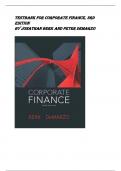 Popular
Popular
-
TESTBANK FOR Corporate Finance, 3rd Edition
- Exam (elaborations) • 1035 pages • 2024
-
- $47.03
- 1x sold
- + learn more
TESTBANK FOR Corporate Finance, 3rd Edition by Jonathan Berk and Peter DeMarzo Corporate Finance, 3e (Berk/DeMarzo) Chapter 1 The Corporation 1.1 The Four Types of Firms 1) A sole proprietorship is owned by: A) one person. B) two of more persons. C) shareholders. D) bankers. Answer: A Diff: 1 Section: 1.1 The Four Types of Firms Skill: Definition 2) Which of the following organization forms for a business does NOT avoid double taxation? A) Limited partnership B) "C" corporati...
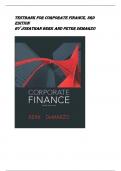 Popular
Popular
-
TESTBANK FOR Corporate Finance, 3rd Edition by Jonathan Berk and Peter De
- Exam (elaborations) • 1035 pages • 2024 Popular
-
- $17.99
- 1x sold
- + learn more
TESTBANK FOR Corporate Finance, 3rd Edition by Jonathan Berk and Peter DeMarzo Corporate Finance, 3e (Berk/DeMarzo) Chapter 1 The Corporation 1.1 The Four Types of Firms 1) A sole proprietorship is owned by: A) one person. B) two of more persons. C) shareholders. D) bankers. Answer: A Diff: 1 Section: 1.1 The Four Types of Firms Skill: Definition 2) Which of the following organization forms for a business does NOT avoid double taxation? A) Limited partnership B) "C" corporati...
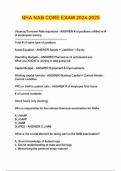
-
NHA NAB CORE EXAM 2024-2025
- Exam (elaborations) • 16 pages • 2024
- Available in package deal
-
- $11.49
- + learn more
NHA NAB CORE EXAM ...

-
NHA NAB/Core 2022-2023 Questions & Answers(GRADED A+)
- Exam (elaborations) • 13 pages • 2023
-
Available in package deal
-
- $11.49
- + learn more
Vacancy/Turnover Rate equations -ANSWER # of positions unfilled or # of employees leaving ------------------------------------------------------- Total # of same type of positions Asset Equation -ANSWER Assets = Liabilities + Equity Operating Budgets -ANSWER Planned rev & anticipated exp. What you KNOW is coming in and going out Capital Budget -ANSWER Equipment & Improvements Working capital formula -ANSWER Working Capital = Current Assets - Current Liabilities PPD or Staff t...
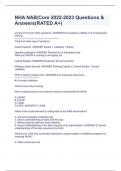
-
NHA NAB/Core 2022-2023 Questions & Answers(RATED A+)
- Exam (elaborations) • 13 pages • 2023
-
- $11.49
- + learn more
Vacancy/Turnover Rate equations -ANSWER # of positions unfilled or # of employees leaving ------------------------------------------------------- Total # of same type of positions Asset Equation -ANSWER Assets = Liabilities + Equity Operating Budgets -ANSWER Planned rev & anticipated exp. What you KNOW is coming in and going out Capital Budget -ANSWER Equipment & Improvements Working capital formula -ANSWER Working Capital = Current Assets - Current Liabilities PPD or Staff t...
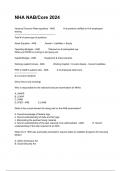
-
NHA NAB/Core 2024 Questions And Answers
- Exam (elaborations) • 13 pages • 2024
-
Available in package deal
-
- $11.39
- + learn more
Vacancy/Turnover Rate equations - ANS # of positions unfilled or # of employees leaving ------------------------------------------------------- Total # of same type of positions Asset Equation - ANS Assets = Liabilities + Equity Operating Budgets - ANS Planned rev & anticipated exp. What you KNOW is coming in and going out Capital Budget - ANS Equipment & Improvements Working capital formula - ANS Working Capital =...
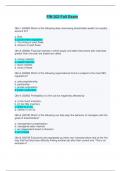
-
FIN 202 Full Exam | Questions and Answers (Complete Solutions)
- Exam (elaborations) • 110 pages • 2024
-
- $35.49
- + learn more
FIN 202 Full Exam | Questions and Answers (Complete Solutions) QN=1 (20283) Which of the following does maximizing shareholder wealth not usually account for? a. Risk. b. Government regulation. c. The timing of cash flows. d. Amount of cash flows. QN=2 (20262) Financial markets in which equity and debt instruments with maturities greater than one year are traded are called a. money markets. b. capital markets. c. stock markets. d. none of these. QN=3 (20269) Which of the following organization...
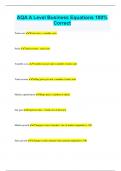
-
AQA A Level Business Equations 100% Correct
- Exam (elaborations) • 5 pages • 2023
-
Available in package deal
-
- $9.99
- + learn more
AQA A Level Business Equations 100% Correct Total costs Fixed costs + variable costs Profit Total revenue - total costs Variable costs Variable cost per unit x number of units sold Total revenue Selling price per unit x number of units sold Market capitalisation Share price x number of shares Net gain Expected value - initial cost of decision Market growth (Change in size of market / size of market originally) x 100 Sales growth (Change in sales amount/ sales amount originally) x 100 Mar...
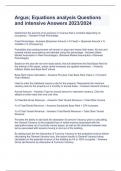
-
Argus; Equations analysis Questions and intensive Answers 2023/2024
- Exam (elaborations) • 3 pages • 2023
-
Available in package deal
-
- $8.49
- + learn more
Argus; Equations analysis Questions and intensive Answers 2023/2024 Determines the percent of an expense or revenue that is constant depending on occupancy. - Answers Fixed Percentage Fixed Percentage - Answers [(Expense Amount x % Fixed) + (Expense Amount x % Variable x % Occupancy)] Probability that existing tenants will remain in place and renew their lease. All new and renewal market assumptions are blended using this percentage - Answers [(New Market Assumption x New Percentage)+ (...
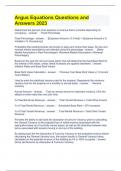
-
Argus Equations Questions and Answers 2023
- Exam (elaborations) • 3 pages • 2023
-
Available in package deal
-
- $13.99
- + learn more
Argus Equations Questions and Answers 2023 Determines the percent of an expense or revenue that is constant depending on occupancy. Fixed Percentage Fixed Percentage [(Expense Amount x % Fixed) + (Expense Amount x % Variable x % Occupancy)] Probability that existing tenants will remain in place and renew their lease. All new and renewal market assumptions are blended using this percentage [(New Market Assumption x New Percentage)+ (Renewal Market Assumption x Renewal Percentage...

How much did you already spend on Stuvia? Imagine there are plenty more of you out there paying for study notes, but this time YOU are the seller. Ka-ching! Discover all about earning on Stuvia


